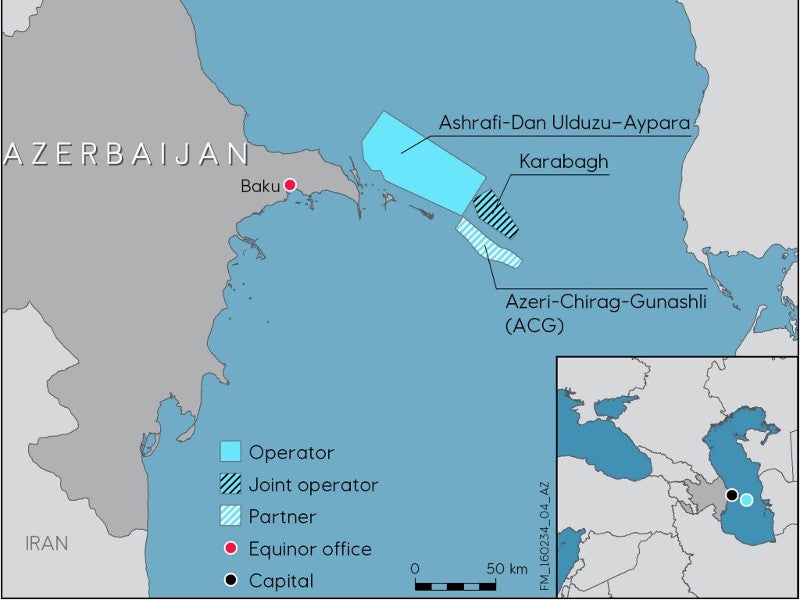The Azeri Central East (ACE) project is the new phase of development in the Azeri, Chirag and Deepwater Gunashli (ACG) contract area in Azerbaijan. It is the seventh oil-producing platform installed in the ACG field.
The ACG contract area is jointly owned by Bp (30.37%, operator), SOCAR (25.0%), MOL (9.57%), INPEX (9.31%), Equinor (7.27%), ExxonMobil (6.79%), TPAO (5.73%), ITOCHU (3.65%), and ONGCVidesh (2.31%).
The $6bn project was announced following an agreement with the government of Azerbaijan to extend the operational life of the ACG field until 2049.
The project is designed to process 100,000 barrels per day of oil and 350 million standard cubic feet per day (Mscfd) of gas.
ACE produced about 3,000 barrels per day in the first half of 2024.
Construction works on the project commenced in 2019 and the oil production started in April 2024.
Azeri Central East project location and background
ACE project is located in the ACG contract area, 120km east of Baku. The ACG contract area is spread across 432km² in the Azerbaijan sector of the Caspian Sea.
The field is developed in five phases known as the Early Oil Project, ACG Phases One, Two and Three, and the Chirag Oil Project (COP).
The contract area is installed with eight offshore platforms, including six production platforms and two processing and utility platforms.
During the first six months of 2024, the average daily production of ACG was approximately 336,000 barrels per day (bpd).
ACE project development details
The ACE project involved the construction of a 48-slot production, drilling and quarters platform. The platform is installed in the middle of the Central Azeri (CA) and East Azeri (EA) platforms at a depth of 137m.
The ACE platform’s jacket has a weight of 16,000t and a height of 153m. It is equipped with three production risers, which include a water injection riser and an oil and gas export riser. It was constructed at the Heydar Aliyev Baku deepwater jackets factory and transported to its designated offshore site at the beginning of 2023.
The ACE topside component, which weighs 19,600t, was built at the fabrication yard in Bayil, close to Baku. This unit was moved to its offshore installation location in August 2023.
The ACE platform has been engineered to harness technological innovations and automated operational systems, which are remotely managed from an onshore control room at the Sangachal terminal. This platform represents the Caspian’s inaugural remotely operated offshore facility.
The project also involves brownfield modifications to the CA compression and water injection (CA-CWP) platform and EA platform to facilitate the export of gas from the ACE platform to the shore during the unavailability of gas injection.
ACE production is anticipated to reach approximately 24,000bpd during 2024, following the drilling, completion, and activation of two additional wells that are scheduled.
Subsea infrastructure details
A subsea cable is installed from the EA platform to the ACE platform to provide power back-up and communication services.
A 16-in-water injection infield pipeline is linked to the existing CA-EA water injection pipeline for the transfer of high-pressure water from the CA-CWP platform to the ACE platform.
Transportation of produced oil and gas
Partially stabilised reservoir fluids are transported to the Sangachal Terminal via a 30-in infield oil pipeline, which is tied back to an existing 30-in diameter oil export pipeline adjacent to the CA-CWP platform.
Produced gas is used as fuel, as well as lift gas and gas re-injection. An 18-in-diameter pipeline exports excess gas to the Sangachal Terminal through a tie-in with the existing gas export pipeline.
Contractors involved
The joint venture of KBR and SOCAR was awarded two front-end engineering design (FEED) contracts. The scope of work of the first contract includes the provision of FEED services for the new platform and associated brownfield tie-ins to existing platforms, while that of the second contract includes the provision of subsea FEED services.
The environmental and social impact assessment for the Azeri Central East project was undertaken by AECOM, a premier infrastructure company.
Subsea 7, a global engineering, construction and service provider, secured two significant contracts from BP Exploration for the ACE project in the Caspian Sea. The work has included engineering, fabricating subsea structures and installing spools, as well as launching a jacket and topside.
Emerson, a technology, software and engineering company, was awarded a $14m contract to provide automation technologies for the new Azeri Central East offshore platform in the Caspian Sea as of October 2020.





